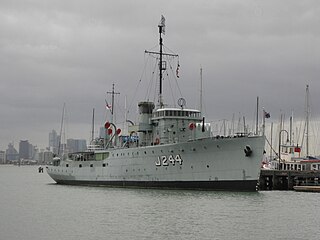
HMAS Castlemaine (J244/M244/A248), named for the city of Castlemaine, Victoria, was one of 60 Bathurst-class corvettes constructed during World War II, and one of 36 initially crewed and commissioned solely by the Royal Australian Navy (RAN).

HMAS Deloraine (J232/M232), named for the town of Deloraine, Tasmania, was one of 60 Bathurst-class corvettes constructed during World War II, and one of 36 initially manned and commissioned solely by the Royal Australian Navy (RAN). In January 1942 she evaded an attack by the Japanese submarine I-124 north-west of Darwin and was jointly credited with the submarine's sinking after inflicting the initial damage. She was present at the bombing of Darwin and survived unscathed.

HMAS Encounter was a second-class protected cruiser of the Challenger class operated by the Royal Navy (RN) and Royal Australian Navy (RAN). She was built by HM Dockyard Devonport and completed at the end of 1905.

HMAS Inverell, named for the town of Inverell, New South Wales, was one of 60 Bathurst-class corvettes constructed during World War II, and one of 36 initially manned and commissioned solely by the Royal Australian Navy (RAN).

HMAS Katoomba (J204/M204), named after the tourist resort of Katoomba, New South Wales, was one of 60 Bathurst-class corvettes constructed during World War II, and one of 36 initially crewed and commissioned solely by the Royal Australian Navy (RAN).

HMAS Platypus was a submarine depot ship and base ship operated by the Royal Australian Navy (RAN) between 1919 and 1946. Ordered prior to World War I to support the Australian submarines AE1 and AE2, Platypus was not completed until after both submarines had been lost, and she was commissioned into the Royal Navy from 1917 to 1919.

HMAS Kanimbla was a passenger ship converted for use as an armed merchant cruiser and landing ship infantry during World War II. Built during the mid-1930s as the passenger liner MV Kanimbla for McIlwraith, McEacharn & Co, the ship operated in Australian waters until 1939, when she was requisitioned for military service, converted into an armed merchant cruiser, and commissioned in the Royal Navy as HMS Kanimbla.
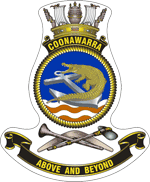
HMAS Coonawarra is a Royal Australian Navy (RAN) base located in Darwin, Northern Territory, and is home to seven fleet units of the RAN. The current commander is Captain Moses Raudino, ADC, RAN.

HMAS Kookaburra (A331) was a Net-class boom defence vessel of the Royal Australian Navy (RAN), which served during World War II.

HMAS Westralia (F95/C61) was an auxiliary cruiser of the Royal Australian Navy (RAN). Built by Scottish shipbuilder Harland and Wolff and completed in 1929, Westralia was operated by the Huddart Parker company until 1939, when she was requisitioned for service with the RAN as an Armed Merchant Cruiser (AMC). Fitted with guns and commissioned in early 1940, Westralia was initially used to escort convoys in the Pacific and Indian oceans. In November 1940, the largest mutiny in RAN history occurred aboard the ship, with 104 men charged.

HMAS Ballarat (J184), named for the city of Ballarat, Victoria, was one of 60 Bathurst-class corvettes constructed during World War II and one of 20 built for the Admiralty but manned by personnel of and commissioned into the Royal Australian Navy (RAN).

HMAS Townsville (J205/M205/A124), named after the city of Townsville, Queensland, was one of 60 Bathurst-class corvettes constructed during World War II, and one of 36 initially manned and commissioned solely by the Royal Australian Navy (RAN).
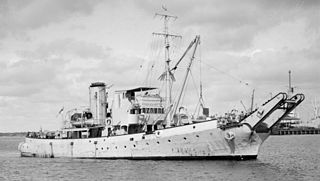
HMAS Kangaroo was a Bar-class boom defence vessel of the Royal Australian Navy (RAN). Although originally ordered as a boom vessel, Kangaroo was at one point to be built as the prototype for what became the Bathurst class corvettes, but reverted to the boom defence design before construction started. Launched in 1940, the ship spent most of World War II operating the anti-submarine net in Darwin. Kangaroo remained in service until 1955, and after several years as an accommodation ship, was sold for scrapping in 1967.

HMAS Moresby was a 24-class "Fleet Sweeping" sloop that served in the Royal Navy (RN) and Royal Australian Navy (RAN) as a minesweeper, anti-submarine vessel, and survey ship. The ship was involved in both World Wars, and was the venue of the Japanese surrender of Timor on 11 September 1945.
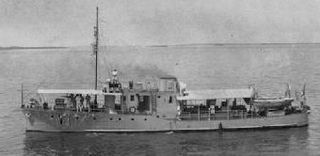
HMAS Vigilant was an auxiliary patrol boat serving with the Royal Australian Navy during the Second World War. Notably it was the 120th ship built by the Cockatoo Island Dockyard and the first aluminium ship built in Australia.

HMAS Terka (FY.98) was an auxiliary minesweeper operated by the Royal Australian Navy (RAN) during World War II. The ship was launched as Sir Dudley de Chair in 1925 as one of the three ships used to supply the construction of the Sydney Harbour Bridge, and from 1928 operated by the Adelaide Steamship Company until she was requisitioned by the RAN in December 1940. She sank while at her moorings at Madang, New Guinea on 26 March 1945 and was abandoned.
HMAS Seamist (10) was formerly a Sydney-based luxury motor cruiser, commissioned as a channel patrol boat into and operated by the Royal Australian Navy (RAN) during World War II. She was one of thirteen similar vessels, known to Sydney siders as the 'Hollywood Fleet'.
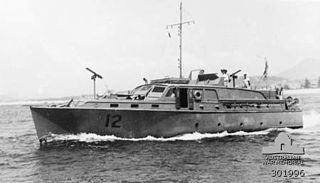
HMAS Steady Hour (12) was formerly a luxury motor cruiser, commissioned as a channel patrol boat and operated by the Royal Australian Navy (RAN) during the Second World War. She was one of thirteen similar vessels, known to Sydney siders as the 'Hollywood Fleet'.

HMAS Marlean (Q20) was a channel patrol boat commissioned into and operated by the Royal Australian Navy (RAN) during World War II. She was one of thirteen similar vessels, known to Sydney siders as the 'Hollywood Fleet'.
HMAS Lolita (14) was formerly a luxury motor cruiser, commissioned as a channel patrol boat into and operated by the Royal Australian Navy (RAN) during World War II. She was one of thirteen similar vessels, known to Sydney siders as the 'Hollywood Fleet'.


















